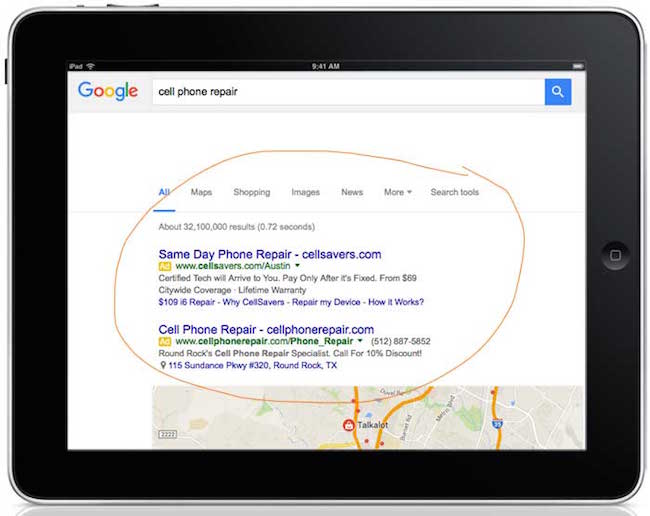How SEO and PPC Work Together

Search engine optimization and pay-per-click advertising are two different approaches to improving your website’s visibility in the search results, a common practice known as Search Engine Marketing (or SEM). SEO uses strategies to get your web pages to appear high up in the organic search results (results that Google deems bidding on relevant to the search, as opposed to paid advertisements). Pay-per-click marketing, also known as PPC, involves certain keywords and then placing ads at the top and sides of the search results for those keywords.
Despite their different approaches, SEO and PPC are similar in some ways. First, they both depend upon keywords for their success. Identifying the best keywords for your website and using them in your SEO or PPC campaign is necessary if you are to reach your target audience. Second, they both share the goal of making your website visible in the search results. With an effective SEO or PPC campaign, you should see an increase in traffic volume and conversions as more people see your site and decide to visit. Finally, both types of search campaigns are used to target the people who need your products and services.
Because of these similarities, SEO and PPC can be used together to create a stronger search campaign. Here are just a few of the ways that you can team up SEO and PPC to maximize your online reach.
Combine SEO and PPC to achieve greater visibility for your website.
Separately, SEO and PPC both improve your website’s visibility in the search results. Together, however, they can help your business to dominate the search results for certain keywords. For instance, while your SEO campaign might get you on the first page of Google for a certain keyword, your website might still be overlooked if visitors are exploring the PPC ads at the very top of the page. However, if you include a PPC campaign for the same keyword, people will see your company name both in the organic search results and in the paid advertisements.

This increased visibility lets people know that your business is reputable and trustworthy. In addition, it allows you to capture the attention of both those who look at the organic results and of those who look at the paid advertisements. By reaching a larger audience, and by improving how that audience perceives your business, you set your website up for greater online success.
Use PPC alongside SEO to achieve visibility faster.
One of the biggest differences between search engine optimization and pay-per-click advertising is the time it takes to get results. SEO tends to be a long-term process, while PPC tends to deliver results almost immediately.
While the time it takes to implement search engine optimization is worth the resulting increase in brand awareness, website traffic, and conversions, it may benefit you to use PPC to boost your website’s visibility in the short term. By implementing a PPC campaign to complement your SEO campaign, you enjoy greater visibility, website traffic, and conversions both immediately and over the long term.
Use both sets of data to make campaign decisions.
Search engine optimization and pay-per-click marketing each provide a set of data regarding keywords, conversion rates, and so forth. Individually, each set of data gives you information about the effectiveness of your campaign so you can make decisions about how to improve it. Together, however, these sets of data allow you to more quickly identify trouble spots in your campaign, locate effective keywords to use, and dispense with search terms that are not helping you meet your goals.
For instance, you may find that a keyword in your PPC campaign is performing remarkably well. In that case, you can incorporate that keyword into your SEO campaign. Alternatively, you can use the most successful keywords from your SEO campaign in your PPC campaign in order to get your PPC campaign off to a successful start. As a result, using SEO and PPC data together allows you to quickly hone your search engine marketing campaigns into effective and profitable endeavors.
Use SEO and PPC to identify high-value keywords.
Much of the success of both SEO and PPC campaigns depends upon targeting the right keywords for your business. Combining these two types of search campaigns can help you to identify these high-value keywords.
For instance, because PPC campaigns yield results right away, they are a good way to test the effectiveness of certain keywords. You can then use those keywords in your SEO campaign as well. The result is that you can improve your SEO campaign quickly, without waiting for your organic search results to show you how your SEO keywords are performing.

Alternatively, as mentioned earlier, if you have an established SEO campaign, you can identify the highest-performing keywords from that campaign and use them in your pay-per-click advertisements. In addition, you can identify the lowest-performing keywords from each campaign and avoid them in the other campaign. By using both campaigns to identify high-value keywords, you can more quickly achieve the website traffic volume and conversion rates that you want.
Split up your keywords to achieve maximum cost-effectiveness.
Often, using SEO and PPC together allows you to use keywords across both campaigns in order to run a more successful campaign. Occasionally, however, you can use your two search campaigns to split up your keyword usage in order to improve the cost-effectiveness of your search marketing.
For instance, in a PPC campaign, the cost of running your advertisements for a certain keyword depends upon that search term’s popularity and the amount of competition available. As a result, certain keywords that are very popular and that many businesses want to use in their PPC campaigns may also be very expensive to bid on. In these cases, it may be useful to run those keywords in your SEO campaign instead, and reserve your PPC campaign for keywords that are more affordable. By doing so, you can cover a broader range of keywords for less money.
SEE ALSO: How Much Does SEO Cost?
Using search engine optimization and pay-per-click advertising together is a strategy that can yield strong results for your business. By achieving greater visibility for your website, using PPC to obtain faster visibility for your site, using both sets of data, comparing SEO and PPC data to identify high-value keywords, and splitting up your keywords to achieve maximum cost-effectiveness, you can create a search engine marketing campaign that meets your marketing goals and allows your business to thrive.
Want to sit back and just get results? Contact us for online marketing today.
Posted in: How To, Internet Marketing, Marketing, PR/Advertising, Quick Tips, Search Engine Optimization, SEM, SEO, WWW Learning Center
Comments are closed.
Latest & Greatest
- Unlocking the Power of User-Generated Content
- Beyond Pretty Pictures: Why Solid Web Design Matters (More Than You May Think)
- Getting Creative with Your 404 Not Found Page Design
- Web Design Solutions: Which Option Is Right For You?
- Maximize Your Site Redesign Budget: What Texas Web Developers Need From You for a Cost-Effective Collaboration
- Responsive Web Design in Austin: Why It Matters For Your Local Business
- How to Prepare Your Website for a PR Campaign
